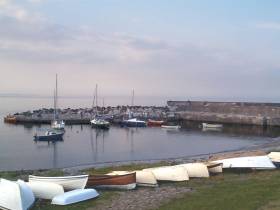Displaying items by tag: Greystones Harbour (Marina)
Kish Lighthouse Original Damaged Base Acquired 50 Years Ago for Greystones Harbour
#Greystones - The Kish Lighthouse on Dublin Bay marked its 50th anniversary a year ago this November however the original caisson base destined for the iconic structure half a century ago instead became part of the now demolished old Greystones Harbour, writes Jehan Ashmore.
At the time of writing last year Afloat contacted Commissioners of Irish Lights that were celebrating five decades since the first light was cast from the then new 31 metre high lighthouse on 9 November 1965 that replaced a lightship. The authority then did not have certain information required given the timeframe involved and no direct records were readily available surrounding the details of the original caisson base. The structure in essence had been damaged during a storm in 1963 that led to a crack in the reinforced concrete caisson which was replaced by a new base and sunk on the site at the Kish Bank.
It was during April of this year, six months after the Kish Lighthouse 50th anniversary that further information emerged as to how the damaged caisson ended up in old Greystones Harbour. Such details arose following an Irish Times obituary on the passing of the late Derek Paine.The renowned boat-builder and native of the coastal Wickow town is where Paine was among key figures in the Greystones Civic Association that were instrumental in acquiring the base of the new lighthouse in 1966. The base was used to extend and protect the now demolished Victorian harbour.
Irish Lights however were able to provide a source reference to the Greystones Guide in which the aids to navigation authority believe the details outlined about the base below is accurate.
The guide's record reads: “1966 – Founded in the late 1950s, the Greystones Civic Association had among their key objectives improvements to the harbour area. An opportunity arose – the Kish lightship was to be replaced with a lighthouse. The first ‘Kish Base’ would have been the foundation for the lighthouse. Built in Dun Laoghaire Harbour and designed to be sunk onto the Kish Bank, it developed cracks after storm damage and could not be used. The G.C.A. acquired it and planned to use it as part of a breakwater to extend the pier at Greystones. After a night of drama when it broke its tow and drifted to the South Beach, it was placed off the end of the pier. However it settled further into the harbour than planned. Having now cracked open, it could not be moved. The intent had been to have it placed more in line with the existing pier. Nevertheless, for the first time, the harbour had some protection from northeasterly gales. Boulders filled the gap between the Kish Base and the old pierhead and the roadway and base were poured with concrete”.
Afloat.ie adds that the former Kish Lighthouse base was providing a pierhead like structure given its apt circular shape at the old yet quaint Greystones Harbour. The current Greystones Harbour Marina features rounded pierheads at the entrance and to the inner harbour. The older smaller harbour only had moorings before been completely transformed against a backdrop of controversy.
The lighthouse completed by Swedish contractor Chriatiani Nielsen JV and Sisk as a reader commented last year would ironically become the developer of Greystones Harbour Marina all these years later. The marina opened in Easter 2013 and currently caters for boats ranging 6 to 60m in length and with capacity initially of 100 berths to increase to 230 berths.























